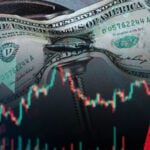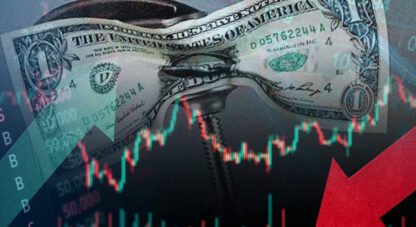Podcast: Play in new window
Dovish Pivot to Melt-Up to Instability
Disclaimer: Advisory services are offered by McAlvany Wealth Management, an investment adviser registered with the U.S. Securities and Exchange Commission. The comments made in this audio recording discuss economic and market trends and are not intended as advice for any particular investor. A short selling strategy involves a substantial degree of risk. Any decision to engage in a short selling strategy should be reviewed with your financial adviser. Past performance is no guarantee of future results.
MWM Q1 2024 Tactical Short Conference Call
May 2, 2024
David: Good afternoon. This is David McAlvany and I’m joined by Doug Noland. We will go through our first quarter conference call here, May 2nd. We’ve titled this “Dovish Pivot to Melt Up Instability.” Welcome, good afternoon. We appreciate your participation in this recap for the first quarter 2024.
As always, we want to thank you, particularly our valued account holders. Greatly appreciate our client relationships. As they say, the days are long, but the years, in this case the quarters, are short. I wish that each of you could experience the conversations, the debates, the processes that go into fulfilling the mandate for Tactical Short. Doug, I am and we all are appreciative of your efforts, disciplined, dedicated. Each week you bring clarity and insight into a jumbled and chaotic world of data.
As a reminder, our weekly communications supplement these quarterly calls in an effort to keep you well-informed. You’ve got the Credit Bubble Bulletin out each weekend, along with Hard Asset Insights. In the midweek, McAlvany Weekly Commentary. And of course, for our account holders, there is a summary for Tac Short clients that comes to you early each week, delivered directly to your inbox.
I’ll open up the remarks today with a review of performance, and then pass the baton to Doug. Then we’ll tag team the Q&A. Please submit any additional questions to Ted@McAlvany.com and Ted will get those to us as we proceed. We’ll address those questions at the end of our formal remarks.
With first-time listeners on the call today, we’ll begin with some general information for those unfamiliar with Tactical Short, and you can find more detailed information available at mwealthm.com/tacticalshort.
The objective of Tactical Short is to provide a professionally managed product that reduces the overall risk in a client’s total investment portfolio. At the same time, provides downside protection in a global market backdrop with extraordinary uncertainty and extreme risk. The strategy is designed for separately managed accounts, it’s investor friendly with full transparency, flexibility, reasonable fees, no lockups. We have the flexibility to short stocks and ETFs, and our plan has been to, on occasion, buy liquid listed put options. Shorting entails a unique set of risks set apart both by our analytical framework as well as our uncompromising focus on identifying and managing risk.
The Tactical Short strategy began the quarter with short exposure targeted at 80%. The target was held steady throughout the quarter, focusing on the challenging backdrop for managing short exposure, a short in the S&P 500 ETF SPY remained the default position for high risk environment.
As we stress during each call, remaining a hundred percent short all the time, as most short products are, and that’s how they’re structured, is in our mind risk indifference. Aggressive shorting can on occasion be rewarding, but the market over recent years, definitely last year, inflicted painful losses on the short side for those indifferent to risk. We believe a disciplined risk management is absolutely essential for long-term success. We structured Tactical Short to ensure the flexibility to navigate through even the most challenging market conditions.
I’ll update performance. Tactical Short accounts after fees returned a negative 7.1% during Q1, the S&P 500 returned 10.55% for the quarter. Tactical Short accounts returned negative 67% of the S&P 500’s positive return. As for one-year performance, Tactical Short after fees returned a negative 17.16% versus the 29.87% return for the S&P 500. Tactical Short, in essence, lost 57.5% of the S&P 500’s positive return. Bear in mind, the target stayed at 80%. Doug managed the rebalancing band very effectively through that period. We regularly track Tactical Short performance versus three actively managed short fund competitors.
First, Grizzly Short Fund, which returned a negative 1.4 during Q1, and over the past year a negative 10.04%. Ranger Equity Bear Fund returned 2.3% for the quarter, with a negative 15.47 for a one-year return. Federated Prudent Bear returned a negative 6.72 during Q1, a negative 18.59 for one year. Tactical Short underperformed the actively managed bear funds for the quarter. On average, Tactical Short underperformed by 515 basis points during the quarter. Tactical Short underperformed over the past year by an average of 246 basis points. Tactical Short has significantly outperformed each of those bear funds we mentioned since inception. From April 7th, 2017 through the end of September, Tactical Short outperformed the three competitors by 2180 basis points or 21.8%.
There are also popular passive short index products, the ProShares Short, S&P 500 ETF, which returned a negative 7.6% for the quarter and a negative 16.58% for the past year, and the Rydex Inverse S&P 500 fund returned a negative 7.46 during the quarter, negative 16% for one year. And then of course the PIMCO Stock Plus Short Fund with a Q1 return of negative 7.01 for the quarter and a one-year return of negative 14.25.
Doug, over to you.
Doug: Thanks David, and good afternoon everyone, and thank you for being with us. With this call scheduled somewhat later than usual, along with recent developments, the first quarter seemed somewhat a faded memory. April was an eventful month for the markets and geopolitics. We hope to provide timely analysis.
Let’s start with some comments on performance. No sugarcoating. It was a disappointing quarter. The markets gave us no breaks. It might not have been a straight line advance for the quarter, but it was close enough. The market posted solid gains in each month without a meaningful pullback. We lagged our competitors for the quarter, which I’m never happy about. Operating largely in the small cap universe, the Grizzly Bear Fund avoided the worst of the big cap market advance. The Ranger Equity Bear Fund was able to capitalize on the reversal of some of the popular short stocks that performed so well in 2023. Our Q1 performance was similar to the Prudent Bear Fund, though Tactical Short outperformed over the past year.
Tactical Short offers some significant advantages over the Bear mutual funds. Our product provides greater transparency, liquidity, and flexibility. For the most part, our approach to rebalancing is advantageous, but the mutual funds do have one advantage that has been impactful over the past year. They generate cash returns on what is referred to as short market balance. Shorting does not reduce cash holdings. In Tactical Short, we sit on cash for collateral for shorting, and this position earns a cash return. When a short position is established, the sale transaction generates cash proceeds that are held in a restricted account at the brokerage until the underlying security is purchased to reverse or to cover the short position.
The Bear mutual funds create large short market balances, affording them the opportunity to reach agreements with the brokerages to receive a return on these funds that is somewhat less than a normal cash rate. In the current high-rate environment, this does provide a marginal performance advantage.
Throughout Q1, Tactical Short maintained the default short position for high-risk environments, the S&P 500. Significant out-performance by the big technology stocks has been frustrating. There are indications this performance dynamic is fading as tech bubble risks mount. More on this topic in a few minutes.
As for positioning, I’m nothing if not disciplined. In such a high-risk speculative environment, we’re extra cautious with beta or the volatility of short exposure. Even though the small caps have underperformed, they tend to be especially volatile during market rallies and short squeezes. The small caps last year had one 25% and two 15% rallies. I’m also mindful of getting caught in big rotations, which are common in market topping processes. When big tech is under selling pressure, the market tends to gravitate to the broader market. I want to avoid rotating to an underperforming sector only to then be caught on the wrong side of a big market rotation. Again, no sugarcoating. This has been such a long and grueling period. The recent speculative melt-up is a fitting finale to history’s greatest bubble.
Let’s shift to the incredible macro environment. It’s difficult to believe we’re now in year 16 of the global government finance bubble, the greatest bubble in human history. With all the fervent bullish narratives and disinformation, it’s especially important at this juncture to remain grounded with an understanding of how the system got into such a mess. After the 2008 mortgage finance bubble collapsed, rates were held at near zero until 2016 and didn’t make it to 2% until 2018. Rates were eased again in 2019 and were pushed back down to zero with the onset of the pandemic.
At less than $1 trillion before the Lehman collapse, the Fed’s balance sheet ended 2008 at $2.24 trillion, and despite telegraphing in 2011 an exit strategy, including a reversal of QE, the Fed’s balance sheet had doubled again to four and a half trillion by 2014. QT, which finally began in 2018, was terminated the very next summer after the eruption of repo market instability. From an August 2019 low of $3.76 trillion, the Fed’s balance sheet had already expanded $400 billion by the eruption of the pandemic crisis. Then in the two years beginning March 2020, the Fed’s balance sheet would again double to almost nine trillion. This was historic monetary inflation and market intervention, nothing short of resorting to the nuclear option to thwart the collapse of credit asset and economic bubbles.
We’ve been hearing a lot lately about American exceptionalism. Unfortunately, I fear future historians will view this catchphrase in similar light to Irving Fisher’s pre-crash 1929 permanent plateau of prosperity. To subscribe to the bullish narrative today is to believe that unprecedented money and credit creation, interest rate manipulation, and repeated market bailouts are healthy promoters of true economic wealth and system stability. If our system were sound, why then have we been running unprecedented peacetime federal deficits, and why is the Fed’s balance sheet still at $7 trillion?
Why is there so much stress within society, and enmity in geopolitics? Does the sound system embolden unprecedented leverage speculation? Massive repo borrowings, carry trades, basis trades, margin debt, and hundreds of trillions of derivatives? Is it healthy to have tens of millions actively gambling on stocks and options? Answers to these questions seem rather obvious. Is this how capitalism is meant to operate, or has something gone horribly astray?
The bottom line is, the US, and really the world, has been suffering from acute and prolonged monetary disorder. The runaway expansions of central bank balance sheets [unclear] of leverage have created tens of trillions of pernicious money—liquidity fueling historic asset bubbles, inequality, inflation, and all sorts of maladies. There’s been nothing similar for almost a century.
There are indeed many alarming parallels between the current cycle and the roaring twenties. Both were spectacular boom cycles fueled by a confluence of transformative new technologies and financial access, bubbles repeatedly resuscitated by central bank stimulus measures.
Alan Greenspan was said to have explained to colleagues in the 1960s that the crash and Great Depression were the consequence of the Fed repeatedly putting coins in the fuse box. After all, recurring government interventions and bailouts emboldened speculators, bankers, corporate executives, consumers, and risk-takers more generally, and perverted incentives and distorted risk perceptions set the stage for what I refer to as terminal phase excesses, which conclude the cycle.
New York Fed President Benjamin Strong administered a fateful coup de whiskey in 1927 that unleashed catastrophic speculative leveraging, culminating in 1929’s melt-up and subsequent panic and crash. Similar dynamics were unleashed from egregious pandemic stimulus. Excess provided an additional shot of adrenaline from March 2023 banking crisis stimulus, including $700 billion of Fed and FHLB liquidity injections, along with what amounted to blanket deposit guarantees.
Financial conditions loosened following bank bailout measures, even as the Fed raised rates. At mid-month last September, most of my financial conditions indicators signaled that the so-called Fed tightening cycle had thus far imposed little system tightening. Conditions, however, began to tighten meaningfully in October, with a booming economy and heightened geopolitical risks weighing on market sentiment. Importantly, with global yields spiking, there were indications that de-risking/de-leveraging—that that dynamic was starting to take hold. And right on cue, an abruptly less hawkish Powell at his November 1st press conference asked rhetorically, “The question we’re asking is, should we hike more?”
The Fed chair triggered nothing less than a historic short squeeze in stocks, Treasurys, fixed income, currencies in EM. The global so-called everything squeeze. Market sentiment had turned bearish with considerable shorting and derivatives hedging. Powell lit the melt-up match. The Nasdaq 100 jumped almost 11% in November. Between November 1st and December 12th, that’s the day before the next FOMC meeting, the Nasdaq 100 returned almost 14%, and the Goldman Sachs Short Index, 18%. The semiconductor index spiked 22%. Nvidia and Micron rose 17%, while AMD was up 40%.
Financial conditions had loosened dramatically. For example, high yield corporate bond spreads versus Treasurys closed December 12th at 363 basis points, down from 438 on November 1st to the low back to April 2022, shortly after the Fed’s initial rate increase.
I believe the FOMC’s December 13th meeting will be debated for decades. Following a conspicuously speculative market rally, a major loosening of financial conditions and a 4.9% Q3 GDP print, Fed nonetheless telegraphed a dovish pivot. So much for traditional lean against the wind policy caution. And never mind William McChesney Martin’s celebrated insight that the job of the Fed is to take away the punch bowl just as the party gets going. Well, the crowd was intoxicated and increasingly irrational. The Fed spiked the punch anyway. From my analytical framework that leans heavily on financial conditions and bubble dynamics, it was reckless monetary mismanagement. It certainly stoked a market melt-up for the history books.
From October 26th lows to March highs, the semiconductors rallied 65%. The KVW bank index, 47%. The NYSE computer technology index, 39%. The small cap, 31% and the S&P 500 28%. Bitcoin ended March up 159% from October lows, trading at a record high of $73,798 on March 14th. Loose conditions turned much looser. From an October high of 5%, 10-year yields were down to 3.8% in late December. By mid-January, the market was pricing in more than six 2024 rate cuts. Investment grade spreads to Treasurys traded down to 88 basis points late in the first quarter, the narrowest risk premium since November 2021, and within only seven basis points of the low all the way back to 2005. Corporate debt issuance was phenomenal with Q1’s $530 billion of investment grade sales, 11% ahead of 2020’s first quarter record. M&A volumes were up 59% year-over-year to $232 billion.
Such terminal phase excess comes with major consequences. For one, the period of late cycle credit excess was further extended. From Federal Reserve data, we know that non-financial debt, or NFD, expanded at an annualized rate of $3.5 trillion during the fourth quarter. This put 2023 NFD growth at $3.63 trillion, down only slightly from 2022. To put this enormous credit expansion into perspective, 2023 NFD growth was almost 50% higher than pre-pandemic 2019’s $2.7 trillion, with 2019’s expansion the strongest since 2007’s then-record $2.53 trillion. Federal borrowings last year increased $2.62 trillion.
But it’s not just the federal government partaking in late cycle borrowing excess. So-called private credit, which is essentially subprime corporate lending, continues its phenomenal boom. Subprime lending has also become a fixture and consumer finance driven by buy now, pay later soaring credit card balances and myriad new age lending platforms. We’re sure hearing a lot of soft landing rhetoric, but our economy is today in a credit and asset inflation induced boom. It’s a bubble economy, acutely vulnerable to any tightening of financial conditions. The situation is highly unstable, instability made only more acute by speculative melt-up dynamics. It will appear a soft landing only while credit market and economic booms continue. But don’t for a minute believe that credit business and market cycles have been relegated to history. When bubbles inevitably start bursting, a hard landing will be unavoidable.
You might’ve heard some of the talk about the so-called neutral rate, referred to as R-star by the economics community. It’s a hypothetical rate at which monetary policy is neither contractionary or expansionary—an equilibrium rate, if you will. Most economists believe this rate is between 2 and 3%, with the latest Fed dot plot placing the longer-term rate at 2.5%. But with the current policy rate double that level failing to restrain the boom, some analysts now argue that the neutral rate must be higher. By neglecting bubble analysis, the entire neutral rate debate is flawed. After all, an identical policy rate in an environment where bubble inflation maintains momentum will have different impacts compared to during a bubble deflation. The primary analytical focus should be on the effects rate policy are having on system financial conditions. And keep in mind that bubbles are creatures of loose conditions. Moreover, bubbles possess incredible capacity to sustain easy conditions. Bubble dynamics perpetuate credit and speculative excess, processes generating self-reinforcing liquidity abundance. The Fed tightening cycle failed to contain bubble excess specifically because policy rates didn’t impose tighter conditions.
This is such a critical point. Powell and Fed officials have repeatedly spoken of significantly restrictive policy when a litany of indicators, including credit availability and expansion, spending and GDP growth, equities and asset prices, and the precious metals all provide evidence of quite loose conditions. An important question. Why is the system proving so immune to policy tightening? To rate increases in QT? Let’s start with credit. Our federal government has been impervious to rising market yields. Politicians certainly haven’t tempered borrowing and spending plans in response to higher policy rates. Washington borrowed more last year than what the entire economy—government, business, and household sectors—borrowed in the pre-pandemic years. Importantly, there remains insatiable demand for government securities. In my nomenclature, government debt retains the critical attribute of moneyness despite now uncontrolled over-issuing. The legacy of Fed QE and market intervention is fundamental to perceptions of enduring liquid and safe securities markets. Indeed, the view holds stronger than ever that the Fed will guarantee Treasury market liquidity. It has become fundamental to contemporary monetary policy doctrine that central banks are committed to open-ended government bond buying necessary to safeguard robust markets.
The Fed liquidity backstop has been instrumental in the ballooning of levered speculation, including a massive basis trade. Here, hedge funds borrow in the repo market to establish highly levered Treasury positions while offsetting interest rate risk by shorting Treasury futures. This enormous securities leveraging operation has generated critical bubble-sustaining liquidity.
It was back in February 2009 as I began warning of an unfolding global government finance bubble (over the years I’ve referred to this as the granddaddy of all bubbles), the adoption of QE and massive deficit spending were fundamental to fanatical reflationary policymaking. This marked the full abandonment of traditional restraints and guard rails. Washington and governments around the globe unleashed virulent bubble dynamics that would prove impossible to control. The sordid history of inflationary policymaking is rife with examples of stopgap money printing sliding into deeply entrenched and eventually out-of-control monetary inflation. And with contemporary money and credit merely debit and credit entries in this colossal, globalized electronic general ledger, there is today no need for wheelbarrows. All the American exceptionalism and AI hype and irrepressible market bubble excess corroborate out-of-control bubble blow-off phase dynamics. I’ll highlight a few recent examples.
A headline from last week: “Micron Clinches Up to $13.6 Billion in US Grants and Loans.” This was part of Micron’s commitment to investing 125 billion in four new US semiconductor fab plants. This money was provided by the 2022 CHIPS and Science Act. Intel is to receive 8.5 and Samsung 6.5 billion. Investment in new semiconductor manufacturing is part of the massive unfolding spending boom in all things AI-related.
This is a case study in late-cycle craziness powered by the perceptions of unlimited finance, perpetual bull market and permanent prosperity. Things have regressed into a perilous global government-driven arms race. The Financial Times ran an interesting article last week reporting on South Korea’s incredible semiconductor boom, described by the country’s president as a semiconductor war. I’ll quote from the article. “The thousand-acre site, a 91 billion investment by chip maker SK Hynix, will itself only be part of a 471 billion mega cluster at Yongin that will include an investment of 220 billion by Samsung Electronics. The development is being overseen by the government amid growing anxiety that the country’s leading export industry will be usurped by rivals across Asia and the West.”
As astounding as tech arms race spending is in the US, South Korea, and many countries, it is surely paltry in comparison to what has been unfolding with government-directed investment in China. The accelerating deflation of China’s historic apartment bubble is Beijing doubling down on state-directed spending in semiconductors, AI, EVs, renewable energy, and myriad cutting-edge technologies for domestic consumption and export. And last week China’s Ministry of Finance vowed support for People’s Bank of China government bond purchases, a policy shift endorsed in a recent book compiling Xi Jinping’s pronouncements on finance and economics.
It wasn’t long ago that Beijing was denouncing Western QE policies. Perhaps Beijing has realized that there are limits to how far it can push its bloated state-directed banking sector. It’s worth adding that China’s sovereign wealth fund bought 40 billion of ETF shares during Q1, part of huge national team government stock market support. China is today demonstrating ultimate terminal phase government finance bubble dynamics. Things have turned only crazier in China as a somewhat different strain of crazy afflicts Japan.
At last Friday’s meeting, the Bank of Japan upgraded its inflation forecast from 2.4% to 2.8% for an economy with a 2.6% unemployment rate. Yet the BOJ held firmly with its near-zero rate policy while reaffirming its bond buying program. The yen was slammed 1.7%, sinking to the low versus the dollar all the way back to May 1990. Reports have Japan spending upwards of 30 to 40 billion Monday to defend its currency, and perhaps more in yesterday evening’s second round.
The BOJ is predictably trapped by its misguided experiment with hyper-monetary stimulus. Years of negative rates and bond market manipulation have left a legacy of epic market distortions and deep financial structural maladjustment. Amazingly, the BOJ now owns over half of the Japanese government bond market. Backing away from bond buying risks a destabilizing spike in yields and massive losses in the marketplace and within its own balance sheet. Meanwhile, the yen suffers the effects of zero rates and ongoing outflows—outflows from yield-seeking domestic sources as well as from leveraged speculators capitalizing on free funding from a weak currency.
Cheap financing used to lever higher yielding securities around the globe. Yen trading has turned disorderly. The Ministry of Finance was understandably reluctant to start a fight with the markets that will be quite expensive and challenging to win. I believe global markets have commenced a period of heightened instability, with the currencies increasingly at the epicenter of destabilizing volatility. Non-stable currencies create a predicament for levered carry trades and leveraged speculation more generally.
It is today reasonable to contemplate the unsustainability and deepening fragility associated with global government finance bubble terminal phase excesses. For starters, ongoing global credit and spending excess ensure persistent inflationary pressures. I’m fond of repeating the quip: that which does not destroy a bubble only makes it stronger. The Fed’s failure to tighten conditions further energized bubble dynamics. We’ve watched commodity prices gain momentum while global yields have surged back to highs since last November. Higher-for-longer applies to central banks around the world. The elevated borrowing costs are a major problem for a highly over-indebted world. They’re an issue for vulnerable debt markets and increasingly fragile currency markets.
In a notable development, Indonesia’s central bank last week surprised the markets by raising rates to support the weak rupiah. Who’s next? What countries lack the wherewithal to stabilize their currencies? Where’s the hot money most exposed? This is an environment where contagion can become a pressing issue.
Today’s backdrop is particularly precarious for heavyweights Japan and China. A rapidly devaluing currency risks unleashing inflation and a bond market crash in Japan. A BOJ forced to accelerate policy normalization risks unmasking epic financial imbalances at home and abroad. I’m assuming so-called yen carry trade leveraged speculation mushroomed into the trillions while creating demand and liquidity abundance in about every nook and cranny of global debt markets—certainly including the US, peripheral Europe, China, and the emerging markets. This leveraged speculation has profited handsomely from zero rate yen devaluation and telegraphed assurances of ongoing accommodation. All bets are off when Japan belatedly recognizes the imperative of major policy tightening to stabilize the yen.
I believe China’s predicament is even more precarious. The renminbi currency trading ban was essentially turned into a hard peg to the US dollar as an apprehensive Beijing is compelled to tighten control. But higher for longer in booming US markets along with the sickly yen have propelled dollar gains. China’s currency appreciated 10% versus the yen over the past year, with more moderate gains versus other Asian currencies. This has placed China’s export sector at a competitive disadvantage right as Beijing presses its bet on booming exports to counter their housing depression.
Beijing needs a weaker currency, and they recently attempted a couple tweaks in the currency band, hoping to orchestrate measured devaluation. But markets reckon band tweaks are only a prelude. Instability immediately forced Beijing to retreat to its hard peg. For evidence of currency peg danger, one can look back to the 1995 Mexican tequila crisis, the devastating 1997 Asian tigers’ domino collapses, the 1998 Russia LTCM debacle, and the 2002 fiasco in Argentina. China rapidly expanded to become the second-largest global economy.
Since 2008, the Chinese banking system has inflated from 8 trillion to 58 trillion, with bank assets surging a record 5.2 trillion last year. Superpower ambitions and bitter rivalry with the US ensure Beijing will work furiously to sustain credit and economic booms. Beijing is also determined to promote the renminbi as a leading global currency.
Increasingly, China’s credit and growth objectives are in direct conflict with a stable currency. Despite its collapsing apartment bubble, China expanded credit a record 5 trillion last year. We can assume that much of this credit was non-productive, financing uneconomic zombie enterprises and epic malinvestment, not to mention the impact of compounding debt service costs for risky borrowers. There is also the nation’s deepening relationship with the Russia, Iran, and North Korea anti-US axis, along with Western business exodus from China. Add the intensifying global backlash against Chinese trade policies, and China is left with quite troubling currency prospects.
The renminbi has been underpinned by China’s 3.2 trillion of international reserves, ongoing trade surpluses, and, importantly, the perception that Beijing would never tolerate a disorderly currency devaluation. The marketplace has good reason today to question both the true size of liquid international holdings and China’s trade prospects. Estimates have China suffering monthly outflows in the range of $40 to $50 billion. Beijing now regularly calls upon its major state-directed banks to sell dollars and establish derivative positions to support China’s currency peg. There are indications that Beijing is leaning heavily on derivatives rather than burning through international holdings. I’ve in the past repeatedly witnessed how such measures and subterfuge promote mounting fragilities. In the case of currency pegs, increasingly desperate measures to sustain the peg ensure banking system and derivatives vulnerability to market dislocation and crisis dynamics. Meanwhile, the growing perception of an unsustainable peg encourages only more aggressive capital outflows, speculative bets, and one-sided derivative exposures, along with a shrinking reserve position.
At some point, it becomes clear that the cost of maintaining the peg is too heavy. There comes a fateful moment when confidence that a disorderly devaluation will never be tolerated turns to fear that it is likely unavoidable. I fear we’re approaching such a critical juncture with China’s currency peg. Devaluation seems inescapable.
Of course, Beijing would prefer a nice and gradual process, but any small devaluation will spur outflows keen to avoid further depreciation, but a big devaluation risks unleashing major instability as banks, derivative operators, and leverage speculators recoil from losses. Any meaningful devaluation would trigger a wave of derivative-related selling and disorderly trading.
Typically, a central bank is forced to respond to currency dislocation with higher policy rates and tighter credit policies. Surging bond yields and faltering financial markets then induce abrupt system tightening and economic turmoil. Gold and silver have recently made powerful upside moves. Commodities generally are showing signs of life. Having taken a backseat during the financial asset meltup, hard assets are beginning to show their safe haven mettle, and analysts are increasingly pondering whether these markets are portending currency crisis.
To conclude, let me offer a brief summary. The world’s most powerful central bank signaled a shift to rate cuts despite exceptionally loose financial conditions, quite strong credit growth, and an acutely speculative stock market. Already vulnerable global bubbles became only more inflated and fragile. The second-largest global economy, suffering the collapse of its historic apartment bubble, is pushing only harder with enormous government-directed lending and investment to meet GDP targets. And the central bank to the fourth-largest economy is maintaining zero rates in government debt purchases despite a sinking currency and rising inflation. No one has been willing to make the tough decisions necessary to rein in precarious excess. All are at heightened risk of losing control. According to the Institute of International Finance, global debt last year rose to a record 313 trillion, a gain of over 100 trillion since the start of the pandemic. There is no doubt that we’re witnessing the greatest bubble ever. As a bubble fueled by government finance guarantees and market liquidity backstops, this super bubble has inflated much greater and for much longer than previous bubbles.
This global bubble at the very foundation of money and credit has been uniquely powerful, unpredictable, and perilous. And bubbles inevitably burst. This global bubble will burst with momentous consequences. Ongoing terminal phase excess ensures global systemic risk continues its parabolic rise until the bubble falters. I believe inflationary policies from all the major central banks and governments more generally have unleashed a period of acute instability. Unfolding currency market volatility foreshadows global market instability. The stage is set for a highly disruptive global de-risking/de-leveraging episode. Myriad bubbles, certainly including the AI phenomenon, are acutely vulnerable to tightening conditions. And with elevated inflation risk and rising global yields, central banks are rapidly losing room to maneuver.
I hope I’m wrong. David, back to you.
David: Well Doug, I think it’s worth pointing out that recent measures of insider sales for companies within the S&P 500 are clipping along at about a 50:1 ratio. And so you may be wrong, but there’s a number of corporate insiders that certainly think it’s time to trim their positions, including Jamie Dimon who has been reluctant to sell shares in JP Morgan for a long, long time, and yet in recent months has sold over $180 million worth of JP Morgan stock. I think it’s worth thinking about his quote from last week, “The markets will do whatever they have to do to hurt the most people.” And he went on to say, “This time maybe one of those setups.” Very, very interesting indeed.
Well, for Q&A, let’s, let’s dive in and start with Michael’s first question, “What is considered a minimum amount to invest in the McAlvany Tactical Short program?”
Doug: David, I’ll tackle that one, but I know you have thoughts on this also. No hard and fast rule here. We would prefer an intention of building a position up to a hundred thousand dollars, but we’ll initially open a Tactical Short account for an amount less than this depending on an individual client’s circumstances. Tactical Short, and I’ll just add to that a little bit. Tactical Short, it should be viewed as only a segment of an investor’s overall investment portfolio, providing some downside protection in a high risk environment. We generally suggest a five to as much as 20% allocation depending on the overall risk profile of a client’s portfolio and individual risk tolerance. We want clients to view Tactical Short as a market risk hedging vehicle—as a tool rather than a way to place a big bearish bet. David, I’ll let you clarify that.
David: Yeah, certainly. As I field calls from prospective clients, the question of, should we view this as a way to make a maximum amount of money on the downside? Well, again, we go back to the structure of many other products which are a hundred percent short all the time, and it’s our effort to minimize risk in a market meltdown. As we spoke earlier today, Doug, you mentioned the Goldman Sachs Short Index being up, was it four, four and a half percent today? There are outsized losses when risk is not managed, and so our effort is to manage those effectively and to give an exposure, which I think you perfectly described as a market hedge for a larger position in equities. And so to be a reliable hedge, risk managed is really important. We have for a number of years maintained that S&P 500 position as an expression of risk mitigation, and only in the instance where it becomes very clear that we are in fact rolling to the downside do the other tools in the toolbox get taken out.
And so that has yet to be introduced, and we do see a long-term market top having been put in, going back to 2021, early 2022, with very unique dynamics which you see as the top is being put in, violent rallies to the upside. And so it’s our effort to be a reliable hedge in a larger portfolio context. So, yeah, completely agree with your comments.
The next question: “We have physical precious metals and coins. Is it wise to convert some of this or purchase outright junk silver? Also, is it wise to convert some of our precious metals to mining stocks? Do you have a price range forecast that silver and gold may increase or decrease for the rest of 2024?”
I’ll take this one. There’s some unique aspects there. As the metals prices consolidate after breakout, which we had going back to 2100 on the gold price, I would consider bolstering positions in the metals.
Junk silver—what that refers to is dimes, quarters, half dollars, all pre-1965. You look at that as an expression of a physical metal holdings when the premiums on junk are really low. This is a time like that. So this is the time to add.
To that broader question, do you switch? Well, I think the premiums on junk are very compelling. When you own that, it allows for a future trade when the premiums return, and basically it allows you to convert the premium gains to free ounces—what we would describe as compounding ounces. We’ve been doing this for 53 years, our sister company. This is what we affectionately refer to as the bag-to-bar trade. There’ve been five of those trades since 2009, and really important to consider your cost basis on the bags as critical. As close to 5% over spot silver you can get the better. We’re closing in on 7%, 8% currently. That includes transaction costs, so we’re getting close to a point where it makes sense.
What we’re looking at on the other side is the bid premiums, and when you go to liquidate, again, the difference between bid and ask—ask is what you pay, bid is what you would receive on a liquidation. The bid premiums have varied from 12 to 18 to 32. The most recent trade was 50% over spot, so I would be considering a move to junk very soon. Again, your cost basis matters if that trade matters.
The other part of the question, converting metals to miners, I think that’s a very different question. It is reasonable depending on your total metals allocations. Physical metals are defensive in a portfolio, and important to maintain on that basis. Very important. I did this exchange back in December of 2015, and I’m glad I did. It was just at the margins of a total portfolio positioning. I’ve contemplated doing it again here recently, but frankly I have sufficient exposure to the miners, and I think physical metals as a hedge will be vital, absolutely vital in the years ahead.
However, if you have a solid position in physical metals, a marginal shift to miners might be warranted. As for price projections, high side for metals in 2024, 2,500 to 2,800, which would take the total price move off of where this most recent move began, roughly 1800, total price move of about 50%. We had the breakout at around 2150, and if you’re looking for downside projections, a retracement back to those levels, a retesting of those levels would be pretty normal. So a measured move above that level to those numbers I gave you a moment ago, 2,500 to 2,800, that’s a measured move of about 30%, where you could end up with disorderly pricing in the gold market with much higher prices. What that would imply is some sort of Treasury market event, US dollar event, and, as Doug’s described in his comments, disorderly trading within currencies globally. Then it’s all bets are off in terms of that price representing destabilization of currencies broadly, perhaps the US dollar as well.
As for silver, so $2,500 to $2,800 gold implies a $43 silver price, and that’s at a 65:1 ratio. If we see the ratio improve further, you could see as much as a $56 silver price this year. That would imply a 50:1 ratio. I don’t expect to see this year, but if we saw a major contraction in the ratio to say 40:1—that’s the gold:silver ratio again—you could have as much as the $70 price on silver, but I would push that into the future in my opinion.
When we look at the ratios and we look at gold and how silver performs relative to it, again, these are not aggressive silver prices based on the ratio, and I think over the next two years we do see the ratio shrinking to 40, perhaps even below 40. In 2025, assuming we continue to see central bank buying and the Western investor, if they enter the markets in force, $4,000 an ounce for gold is certainly reasonable. That would imply $100 silver at that 40:1 ratio.
The key here is that Western investors have yet to come into the market as investors in the West do enter the market, I think that’s where you see the ratio drop dramatically. And then of course when you get to 40:1, you begin shifting back away from silver back towards gold. The difference between the current 85, 86:1 and a 40:1 ratio, you’re talking about having twice the number of ounces of gold. So there’s some attractive trades over the next few years. I think working with your McAlvany Precious Metals advisor closely over the next few years will allow for your defensive physical metals position to even take on an offensive character if you’re having a discussion about those ratios. Silver and miners are poised to outperform. You just have to have a strategy. I think that’s really key.
The next question from David, “Thanks for all the outreach and educational work you do every week. It’s greatly appreciated. I look forward with excitement to the Wednesday podcast and the Saturday morning Credit Bubble Bulletin. My question, how often is an independent physical audit of gold and silver done in the Vaulted program to verify the product is there and stored properly?” Those are done annually. We just finished the Royal Canadian Mint audit and the HSBC audit. We’ll publish that to the Vaulted website here in the next few weeks.
The next question is also on silver, so let me just plow through that real quick. Inflation has been raging for over two years. Is silver really a hedge against it? It’s the Moneyball movie question. “If silver is a hedge against inflation, why isn’t it hedging?” Great question.
I would say there’s no direct real-time hedge from a silver exposure when you’re talking about inflation statistics. I think of metals as an imperfect hedge in the sense that they don’t match in real time, but they do catch up over time. There are a variety of circumstances that send investors scrambling to own the assets, and over long periods of time the metals do reflect the loss in purchasing power of the currency. That can be over decades. Sometimes it takes years. Rarely is it in months or weeks. The good news is, typically when it lags as it has for, call it 18 months, 24 months, there is a catch-up phase. I think the recent break over $26 an ounce is the start of that catch-up phase, so we would expect to see it leading, not lagging. And time will tell, but the gold:silver ratio should start to contract, indicating outperformance by silver.
Again, what you see is that investors in the West are a critical element to the performance of the silver market—far more than gold, where gold has certain appeal on a cultural basis within certain geographies. In terms of central bank buying, silver’s a non-starter. So it does depend on a certain segment of the investor population.
What causes those investors to flock to the metals? Let’s just say they’ve had a few distractions recently, outperformance in equities, real estate market here domestically holding up quite well. If you look at ETF flows, what it suggests is that the Western investor has not been concerned up until now, and thus the money flows out of those ETFs have been actually out of the sector, not into it. So I think we still have a significant lag higher in the metals just based on the Western investor coming in with reinvigorated interest.
Perhaps that shift as the investor community comes to terms with the Fed being wrong about taming the inflation beast, as three prints in a row suggest, and of course yesterday’s comments from Jerome Powell. Now the data throughout a complete quarters suggests that it is not gone, it is not going away—certainly not on the time frames that they were hoping for or expecting. So maybe the Western investor needs more proof of concept first, and I think we do have that to some degree—gold moving first; silver follows the trend. That’s a very typical pattern. Gold having broken out over a 12-year resistance level. I think silver will play catch up.
So, coming back to the basic question: no, if an inflation print is stronger than expected, you don’t see an immediate move in the metals. It takes time to migrate investors en masse, and I suspect that that could be triggered by a stock market sell-off, more acute pressure in the global financial markets. Those types of things would certainly inspire gold buying and then silver buying thereafter as smaller investors look for a way to play the space with a more value-oriented mindset.
Let’s see, Doug, the question from Bob, “For every 2,000-point drop in the Dow or the equivalent decline in the S&P 500, what is a reasonable percentage of expectation for Tactical Short to go up?”
Doug: Sure, sure David. Yeah, that’s a good question. I’ll start with, while you were answering one of those questions, David, I jumped on the Bloomberg again. The Goldman Sachs Short Index was up 4.7% today. The Russell 2000 was up 1.8%, double the return of the S&P 500. So today was a decent day to be in the default short position relative to some of the other areas of the marketplace.
Okay, so to the question, it might be helpful to think in terms of percentages, with the Dow at roughly 38,000, a 2,000 point drop equates to roughly 5%. The Tactical Short target currently is 80% short the S&P 500 Index. So if the Dow declines 5%, and let’s assume that the Dow and S&P move in tandem, we would expect Tactical Short to capture eight-tenths of the 5% decline, or 4%. Simple enough, at least to get started. But your question asked for every 2,000 point drop, so here’s where it gets more complicated.
I’ll use this opportunity to explain some of the nuance of managing short exposure. We plan on rebalancing exposure as the market declines. That means we will add to short exposure to maintain the target level. I’ve discussed this in detail in previous calls, so I’ll attempt an abbreviated version here.
Managing short exposure is different than managing on the long side. When the market declines and short positions make money, account value rises while the size of the short position actually declines. Think in terms of being a hundred percent short a market that declines 10%. Simplistically, your $100,000 account adds 10% of profits to reach $110,000 because the market declined 10%, while the market value of your short position declines 10% to $90,000. So when the market goes your way 10%, your overall short position would drop to 90 divided by 110—your short position divided by your account value, or 88% short.
Well, we plan on rebalancing. We want to add to short exposure as the market retreats to generate compounded returns in what we expect to be a protracted bear market. So back to your question, the first 2,000 points, or 5%, that move we make our 4% or so. But the next 2,000 points as it goes, let’s say from 36 to 34,000, the next 2,000 points lower will be a somewhat more than 5% decline, and we would expect to make more than 4%.
And think of a hypothetical example where the market declines 20% off of a base of a hundred, and I know these numbers are confusing, I apologize. So the market’s now at 80—20% decline from a hundred—and let’s say for discussion purposes the short made 20%. So our account value went from a hundred to 120 as we’re making returns.
At that point, if the market then declines another 10%, the market declines eight, going from 80 to 72, right? Another 10%, 80 to 72. While our base goes up 12, we make 10% off of our base of 120. So our base goes to 132. So in this example, the market dropped 28% from the hundred base level to 72, while the short account gained 32% going from a hundred to 132. And that’s probably really confusing, but that hypothetical example shows how compounding works, and I expect the market to drop by more than half, and returns can really compound with big drops over time because it’s all about percentages. And we’ll be making a cash return on our cash position that is growing over time, also helping with compounding.
But there’s a big caveat here: the ability to compound really depends on the nature of the market’s decline. If the market crashes, that wouldn’t provide us the opportunity to rebalance and compound the gains like we would in a more stable decline. Also, in a really volatile market environment, rebalancing becomes a challenge, and it can hurt returns when rallies require reducing short exposure to get back to target. So the big wild volatility can be a disadvantage with rebalancing—provide trading opportunities, but rebalancing tough.
Importantly, sound analysis and some market savvy play key roles over time, especially in a volatile market. Our goal is to capture the full percentage decline of the S&P 500 in a bear market environment. Hopefully we’ll have the opportunity to opportunistically broaden our short exposure, capturing some alpha by being short an underperforming sector. I also hope for some timely put option purchases—my fingers are crossed—to boost returns. We have kept our options powder dry thus far. There are definitely moving parts that drive performance, but I hope that explanation is at least somewhat helpful and thank you for your question.
David: Next question— Before I go to that, it’s— I just think about the last several years, Doug, and I reflect on your skill set, the talents and the tools that are still in the box. And it’s almost like the general who has been anticipating war and is more than ready for it, but there is still peace. We get to see the talents on display most obviously when the context shifts, and that I think still lies ahead.
What are some alternatives to the conventional 60/40 portfolio investing, gold, bitcoin, foreign currency, artwork, crowdfunding? I’ll start this if you want to throw in thoughts, feel free. While we’re partial to hard assets and our hard asset strategy—which is another offering through McAlvany Wealth Management—there is income generated from the dividends, and that is, to us, a reasonable alternative to coupons in the bond market from exposures to bonds and fixed income. And our equity exposure is tied to real things. We like infrastructure, we like real estate—select real estate, global natural resources, precious metals mining companies. That’s how we solve that problem. We have tailwinds for that strategy. The thesis is getting plenty of confirmation, and that is even as the 60/40 portfolio faces more and more headwinds. So there is an alternative to the 60/40 portfolio. I think we’ve created something that is very appropriate to the context that we’re in.
There’s a unique thing in the gold market in terms of how professional managers view it and how I think they will view it. Gold will to some degree displace the bond market allocation for professional asset managers at the margins in the years ahead. And if you look at top quality miners that are paying anywhere from 3% to 6% dividends, you’re talking about getting exposure to inflation protection and income—getting the best of both worlds in terms of what you’re supposed to get from the 60/40. That likely is a better bond-like position going forward, and will come to be appreciated as such by the investment community.
Rates are likely to go higher over time. That is, again, the headwinds that we see punishing fixed income allocations in a replay of the 2022 dynamics—proved challenging for the 60/40 portfolio, proved challenging for the risk parity strategy and others like it.
So we like the miners. You have to be mindful that not all of them are created equal. We’ve put a lot of effort into identifying an optimal allocation of that space. That’s something you can talk with us about.
The other things listed on that shortlist, crowdfunding, micro lending, not a real fan. You don’t have protective covenants, you don’t really have liquidity. The shared ownership of art is fascinating given that you can do that on a fractional basis given the technology that drives that. It’s a curious option. I mean you get the pride of ownership, probably not the direct enjoyment of owning a piece of art. Perhaps as a diversification, it’s something to consider.
Foreign currencies, I think foreign currencies are fraught. Central banks are sort of in a race to the bottom if you think about many of the comments that Doug was making earlier. I think if you’re looking for currency diversification, that’s one of the things that you can look to gold as—that is, just retaking its former position and role within the financial markets. Today we treat it as a commodity, but for 5,000 years it’s been the most reliable form of currency. So I think I’d rather own hard assets. Specifically gold is an alternative to foreign currencies.
Let me go through this next question real quick. It just has to do with IRA structure, “With likely demands on public funds in the future, what suggestions—” Doug, did you want to say anything else about sort of an asset allocation beyond the conventional 60/40?
Doug: No, David, you handled that well. Thank you.
David: So “with likely demands on public funds in the future, what suggestions do you have concerning IRA conversions to Roth contributions, into Roth IRAs versus just using only non-IRA accounts?”
I take that question to be tied to our current fiscal situation, and I think it’s a very important question. The assumptions that we’ve been operating on the basis of, with solvency with our Treasury, and yes, we’ve seen deficits here and there, but as Doug pointed out earlier, we are now logging some of the largest deficits and we’re not in the middle of a global financial crisis. We’re not in the middle of a world war, and yet we’re seeing deficits as a percentage of GDP on par with those kinds of environments.
The Roth conversion story is a strong one. Again, classically the argument has been that in retirement you’ll see a reduced level of income. Therefore, a smaller hit from income taxes as your tax rates should be at a reduced level compared to when you’re in your peak earning years.
The argument in favor of traditional IRAs to the Roth IRA conversion, it hinges on the appetite of the Treasury to fund those massive debt and deficits. We know they’re running at unsustainable levels, and the only way for them to solve that is to increase your tax brackets. If that scenario materializes, having settled the tax bill now may be to your advantage. So you’re dealing with known factors, and of course that can only be done optimizing that in conjunction with your CPA. You’re just balancing out—the real question there in terms of converting to a Roth or contributing to a Roth—knowns versus unknowns.
We don’t know what the Treasury will do to tax rates, but it’s a reasonable bet. I think it’s a very reasonable bet that to drive increased revenue, they’ll have to raise them in the years ahead. That upends the conventional wisdom of waiting to pay your taxes in an IRA till you’re in those non-peak earning years. I would, again, in conjunction with counsel from your CPA, I would consider settling it now, just spread it out over multiple years so you’re not bumping into higher tax brackets just to get that done.
Other questions, not a part of this one, but I’m often asked, what about the sticky fingers of government? Should we even be in an IRA? I think that you— With the underlying question being, should we just leave the IRA structure altogether, liquidate, have those assets in closer control? I think I would be cautious in doing that. There is a real value, whether it’s the traditional or the Roth, to maintain a pocket of capital where capital gains are not an issue. To try to settle up on one score and figure out what you’re doing with the income tax liability. Don’t forget that those assets have the potential to appreciate depending on how you’ve invested them, and you want to be able to avoid the capital gains by maintaining under that umbrella, so I would maintain the structure. That would be to your long-term advantage.
This is a real quick question on T-bills, so feel free to weigh in on it, Doug. “I’m responsible for managing a million dollars—” Well, actually my response is T-bills. The question is going a different direction, but “I’m responsible for managing $1 million-plus in brokerage accounts for my elderly parents, and what is the safest way to reallocate funds from low-performing accounts to funds earning 12%-plus quarterly?” And just straight away, I have to say I think that’s a typo because 12% quarterly is not a reasonable expectation to have. I can think of only one hedge fund that has outperformed all others over the past 30 years, and their returns never touched 12% quarterly returns. I’m thinking of Duquesne capital, 30% annual returns. And you could extend the list. If you wanted to look at Warren Buffett’s, his annualized returns over 50 years are roughly 19%.
Druckenmiller still takes the cake with Duquesne. Leon Levy, Bill Ackman, there’s a few that have gotten into the teens, but again, you’re talking about annual, not quarterly rates. So 12% annual is, even in most instances, with any consistency, a stretch. I’m going to focus in on the safety aspect and the information provided in the question which was these funds are for my elderly parents. I’d say prioritize safety, and that shows real relevance in a market which is sort of turning topsy-turvy. Short-term T-bills are over 5%. To have a 5% essentially risk-free rate makes a lot of sense to me. So for your parents, I would lean heavily on T-bills to supplement their current income needs. Hedge the dollar risk that you have there with bullion. That’s the scenario you’ve laid out. I think your responsibility is to safely maintain value for your parents. Minimize risk to the greatest extent possible. Don’t focus on returns, focus on asset preservation. If something changes—the inevitable future event of your parents passing—a different risk profile could be considered at that point. Doug, given that setup, anything you would add?
Doug: Yeah, I would just add, David, that this would be an especially dangerous environment for rotating from underperforming to the outperforming because it’s been so speculative that some of the most speculative investment vehicles are the most vulnerable today, so people will rotate into them just in time for painful reversals. So I would just be very cautious with the idea of rotating from low performing to high performing.
David: Well, it takes us back to Dimon’s quote, Jamie Dimon’s quote, “The markets will do whatever they have to, to hurt the most people.” And that is really an expression of the psychology within the markets. You have the greatest confidence building it at precisely the wrong time, and for his follow-up to that quote, “this time may be one of those setups.” Your rotation into the best performing assets really puts you at a dangerous position. People would say, well, AI is going to change the world. I just want to own a little bit of NVIDIA. Keep in mind, the last significant downturn in NVIDIA, I think it was a 65% decline, and that was only, that was 2022. So you can have really significant drawdowns, really, really significant drawdowns, and I think that was one of the things that people had to come to terms with as they were chasing returns in the year 2000, where technology shares were down 60%, 80%, in some cases, 90%. But the energy was there, the motivation was there, the eye-popping returns were there, and the market did exactly what it does at the tail end of a cycle: draws people in. It hurts the greatest number of people there at the tail end.
Doug: David, I’ll just add, I was just thinking as you were answering the question, that Charles Kindleberger, one of my favorite economists, I’m paraphrasing him, but he makes this point that nothing causes more angst than watching your neighbor get rich. And I always think in terms of, I speak of this terminal phase of excess. Part of it is, there’s just so much angst. People cannot— They have to get on board, they can’t watch everybody else make money, caution to the wind, and they jump on board at the last big meltup. And that’s an important reason why the market causes the most grief to the most number of people. People just can’t not participate at the end.
David: This is going way back in history, but as evidence of that, you’ve got the John Law bubble. This goes back several hundred years, and I think of Richard Cantillon, who was an objective observer and saw this as subterfuge. He actually made money on the short side at one point during that whole cycle of up and down and up and down, just crazy volatility at the tail end of a market cycle. And in the end, he couldn’t even help himself. He saw that it was a bubble. But to your point, you can’t watch your neighbor get rich without anxiety, and he did lose a bundle of money going into that particular investment scheme.
Psychology is a very powerful thing. Accounting for it is one of the most important things that you can do as an investor, knowing yourself in the context of the markets, because you can be subject to not only the temptations of greed, but also the pressures that come as the market has extracted its worst. At a market low, the same thing is in effect. It’s the opposite end of the spectrum, of course, but no one wants to participate at a market low. And so accounting for your psychology is one of those things that’s absolutely critical to being a successful investor.
“Doug, what’s the risk profile of this Tactical Short. I’m with you on the approach, don’t get me wrong. I just like to understand the maximum risk being taken.”
Doug: Sure, I’ll give it a shot here. We diligently manage risk, and as David, as you communicated at the beginning of the call, Tactical Short, since inception has outperformed our three actively managed competitors by an average of 2,180 basis points, 21.8 percentage points. Two of our competitors have suffered individual quarterly losses of about 30%, so losing 30% of your money in one quarter. Tactical Short’s worst drawdown was Q2 2020’s 12.05% loss, and that was during a quarter where there were powerful short squeezes and an S&P 500 that returned 20.4%. We have kept short exposure well below 100% and hunkered down in the default S&P 500 short specifically to avoid outsized losses. That’s been a priority. Avoid outsized losses because in this kind of environment on the short side, it can be walking through a minefield. You can look pretty good for a while until you hit a mine.
Shorting is risky, there’s no doubt about that. We strive for a risk profile for Tactical Short that is lower relative to other short products. As for the maximum risk being taken, that’s a difficult one to answer. Hypothetically, shorting entails unlimited risk. Since Tactical Short’s inception back in 2017, the S&P has returned 150%. If we had not managed risk and rebalanced short exposure along the way, accounts, they would’ve been at risk of losing all their value. They certainly didn’t do that. So I guess maximum risk depends on your investment horizon. Tactical Short lost 67% of the S&P 500’s positive return during Q1 and about 58% of the S&P’s one-year return. Those are good numbers. Those are numbers to help you contemplate a risk when you’re thinking about what the maximum risk is.
I would like to think that the market has pretty much wrapped up a historic meltup. We’ll see, and this has been a worst case scenario for Tactical Short for this strategy, and we have survived. We’re still in the game. Our focus on avoiding high beta short squeezes and outside losses. It’s been the right approach. It’s saved itself. So thank you for your question.
David: Well, we’ve gotten to the end of our questions, and appreciate your participation in the call today. We would encourage you to be in touch if this is a product that you’re kicking the tires on, be in touch, schedule a call with either myself or Doug, and we’d be happy to explore how this fits as a hedge for your total market portfolio. And it’s a privilege. It’s a privilege to work with you and to partner with you in some challenging times. I think one of the things that you have to account for when you’re managing your own resources is the team that is working with you, whether that’s a CPA or legal advice. You want the very best, and you want to lean into experience and wisdom. And I think what you find, and just going back to my earlier comments, you won’t find anyone on Wall Street who’s more disciplined and dedicated to their work.
My respect for Doug and his diligence every day, come in, roll up the sleeves, look at the markets, and then figure out the best positioning for Tac Short. There’s a level of integrity in the work that he does that you just don’t find, you just don’t find on Wall Street. So as you’re putting together your dream team of a CPA, of legal advice of folks that are helping not only put points on the board but also help from there being points scored against you, both the offense and the defense. Engage. And I want you to ask that question next time you’re talking to a financial advisor or third-party asset manager, do they have that same level of integrity in terms of their dedication and discipline to the work that they’re doing? I think you’ll find incredible value in this team that you’ve got access to. So we appreciate you taking the time. If you’re kicking the tires, let’s get on a call and figure out how this works for you. Thanks so much for joining us again for Q1 and our summary of the dovish pivot there in the fourth quarter, the meltup which we’ve seen subsequently, and the instability which is throughout the financial markets.
Doug: I would just like to say, I want to thank the listeners. I want to thank all of you that are on the live call, those that will listen to the recording, even those that will read the transcript. I’m very appreciative of you for taking your valuable time to listen to what we have to say. So thank you and good luck everyone. Take care.
















